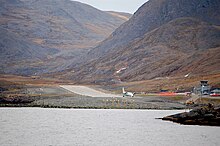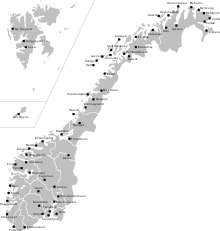
Back قائمة مطارات النرويج Arabic Liste der Flughäfen in Norwegen German Anexo:Aeropuertos de Noruega Spanish Norra lennujaamade loend Estonian فهرست فرودگاههای نروژ Persian Liste des aéroports les plus fréquentés en Norvège French Aeroporti in Norvegia Italian ノルウェーの空港の一覧 Japanese Liste over flyplasser i Norge NB Список аеропортів Норвегії Ukrainian

Norway has 98 airports which are certified or have been designed an International Civil Aviation Organization airport code (ICAO code).[1] Forty-eight airports facilitate public flights, including one heliport, Værøy Heliport.[2] Forty-five of these are owned by the government through its airport operator, Avinor. Scheduled airports are grouped into primary airports, which are sufficiently large to serve jetliners, and regional airports, which can only handle regional aircraft.[3]
The airports used only for general aviation (GA) are owned by a mix of municipalities, aviation clubs and private companies.[4] The latter include some which are controlled by the state or municipalities. Two are owned by the Norwegian Armed Forces.[5][6] The Royal Norwegian Air Force has ten air stations which are co-located with primary airports ("joint" airports).

Oslo Airport, Gardermoen is by a factor of almost four the busiest airport in the country, about half of which is international services.[2] It opened in 1998—replacing Oslo Airport, Fornebu—[7] and serves as a hub for Norwegian Air Shuttle and Scandinavian Airlines (SAS).[8] It is followed by three other major airports, Bergen Airport, Flesland; Stavanger Airport; and Trondheim Airport, Værnes.[2] These act as focus cities for said airlines. The four next airports are of almost equal size.[2] Sandefjord Airport, Torp serves low-cost airlines in Eastern Norway and are often branded as "Oslo" by airlines such as Ryanair.[9] Bodø Airport and Tromsø Airport act as hubs within Northern Norway, from which Widerøe flies to regional airports. Oslo, Trondheim and Bergen have a similar function in Southern Norway.[3]

Norway is the country in Europe with the most airline trips per capita. The routes from Oslo to Trondheim, Bergen and Stavanger are all amongst the ten busiest in Europe. Contributing causes are a low population density, a rugged geography and limited population in the interior and the north, which combined have resulted in a poor road and rail infrastructure.[10] Many smaller airport have short runways which permit only fairly small aircraft on short routes. Future lack of compatible aircraft has started plans to extending some, close down some (combined with road improvement) and to replace a few with new airports.
- ^ "Location Indicators by State" (PDF). International Civil Aviation Organization. 17 September 2010. pp. 82–83.
- ^ a b c d "Passenger statistics". Avinor. Retrieved 20 April 2017.
- ^ a b Bråthen, Svein. "Luftfartens rolle i regional samferdsel" (PDF) (in Norwegian). Avinor. Archived from the original (PDF) on 9 March 2012. Retrieved 27 July 2010.
- ^ "Liste over godkjente lufthavner og flyplasser" (in Norwegian). Civil Aviation Authority of Norway. 1 November 2013. Retrieved 16 November 2014.
- ^ Barr, Susan (1991). Jan Mayen (in Norwegian). Oslo: Schibsted. p. 245. ISBN 82-516-1353-1.
- ^ Kjeller flyplass 75 år (in Norwegian). Forsvarets forsyningskommando. 1987. p. 93.
- ^ Bredal, Dag (1998). Oslo lufthavn Gardermoen: Porten til Norge (in Norwegian). Schibsted. p. 42. ISBN 82-516-1719-7.
- ^ Kaspersen, Line (30 July 2014). "– Store muligheter for enda flere langruter". Dagens Næringsliv (in Norwegian). Retrieved 3 December 2014.
- ^ Tjomsland, Audun (2005). Høyt spill om Torp (in Norwegian). Sandefjord: Tjomsland Media. pp. 197–205. ISBN 82-997212-0-2.
- ^ Grønli, Kristin Straumsheim (7 June 2007). "Så mye flyr vi" (in Norwegian). Forskning.no. Retrieved 3 December 2014.